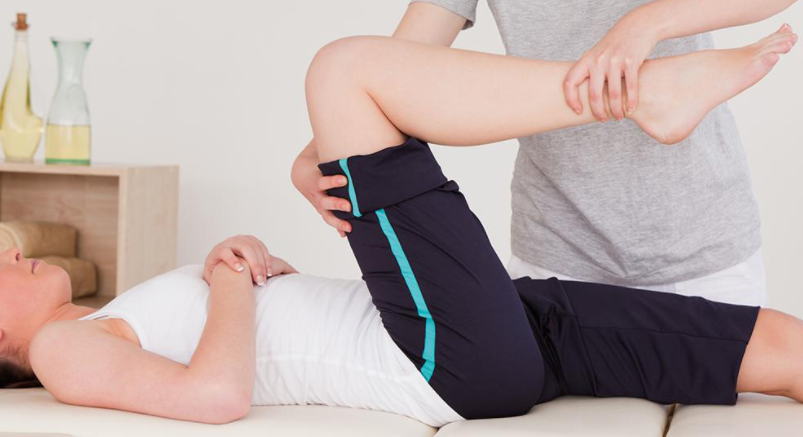
Lane Cove gym rehabilitation for ACL injuries
Anterior cruciate ligament (ACL) injuries can be devastating whether you are an athlete or not.
Apart from being very painful, ACL tears require adequate care and rehabilitation from the outset to ensure the best long-term outcome. Unfortunately, re-rupture and graft failure are both medical realities for many people who have had an ACL reconstruction.
Lane Cove Physio features a purpose built prehabilitation and rehabilitation gym designed to take you through your bespoke recovery program from start to finish.
You can’t rush recovery
According to a recent study of athletes aged in their 20’s, those who returned to strenuous sport 9 months or more post surgery had a lower rate of new ACL injury compared with those who returned earlier than 9 months after ACL injury.
Those who returned to sport earlier than 9 months post injury were 7 times more likely to sustain a second ACL injury.[1]
Preoperative Rehabilitation
After an ACL injury, deficits occur in strength, proprioception, muscle timing and gait patterns in both the injured and uninjured leg.[2]
Preoperative rehabilitation, AKA prehabilitation, is designed to prepare patients undergoing ACL repair for immobility following surgery and to improve motion prior to the procedure.
Rehab programs vary widely following ACL injury and are largely dependent on your desired level of sport, return to play timeline, and presence of other injuries.
Studies have shown that extended prehabilitation consisting of progressive strengthening and neuromuscular training leads to better functional outcomes (assessed with Knee Injury and Osteoarthritis Outcome Scores) and higher return to sports rates compared to standard rehab when assessed 2 years after ACL repair.[3]
Rehabilitation after an ACL repair
Postoperative rehabilitation at Lane Cove Physio aims to address knee neuromuscular function, mechanics, sport-specific training, and eventual return to-activity/sport with the lowest risk of reinjury possible.
Early and ongoing physiotherapy is crucial to restoring normal ROM, weight-bearing, pain management, decreasing joint effusion, and improving quadriceps and hamstring muscle and strength.[4]
Hydrotherapy for ACL recovery
The properties of water (buoyancy, density, hydrostatic pressure and viscosity) can facilitate the development of an all encompassing functional recovery program following ACL injury.
Aquatic therapy has been shown to aid in:
- reduction of pain and swelling;
- recovery of gait;
- maintenance and/ or development of CV fitness;
- motor pattern/ coordination training;
- earlier introduction of plyometric training and
- between-session recovery and optimized load management[5]
Before returning to sport
Return to sport testing should involve assessment of specific functional skills that demonstrate your quality of movement, strength, range of motion, balance, and neuromuscular control of the lower extremity and body. It is also important that clearance to full participation should be a multidisciplinary decision involving the patient, parent if the patient is under 18 years of age, surgeon, and physiotherapist.
Clearance to return to sports participation should then be followed by a carefully structured plan to return to practice before a progressive return to competition in order to keep ACL reinjury rates to a minimum.
To book an appointment with one of our specialist physiotherapists, please call us on (02) 9428 5772 or send us an email at [email protected].
[1] Beischer S, Gustavsson L, Senorski EH, Karlsson J, Thomeé C, Samuelsson K, Thomeé R. Young Athletes Who Return to Sport Before 9 Months After Anterior Cruciate Ligament Reconstruction Have a Rate of New Injury 7 Times That of Those Who Delay Return. J Orthop Sports Phys Ther. 2020 Feb;50(2):83-90. doi: 10.2519/jospt.2020.9071.
[2] Wojtys EM, Huston LJ. Neuromuscular performance in normal and anterior cruciate ligament-deficient lower extremities. The American Journal of Sports Medicine. 1994;22: 531-536.
[3] Failla MJ, Logerstedt DS, Grindem H, et al: Does extended preoperative rehabilitation influence outcomes 2 years after ACL reconstruction? A comparative effectiveness study between the moon and delaware-oslo acl cohorts. Am J Sports Med 44:2608-2614, 2016.
[4] van Melick N, van Cingel RE, Brooijmans F, et al. Evidence-based clinical practice update: Practice guidelines for anterior cruciate ligament rehabilitation based on a systematic review and multidisciplinary consensus. Br J Sports Med 2016;50:1506-1515.
[5] Buckthorpe M, Pirotti E, Villa FD. BENEFITS AND USE OF AQUATIC THERAPY DURING REHABILITATION AFTER ACL RECONSTRUCTION -A CLINICAL COMMENTARY. Int J Sports Phys Ther. 2019;14(6):978-993.



